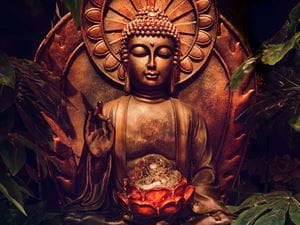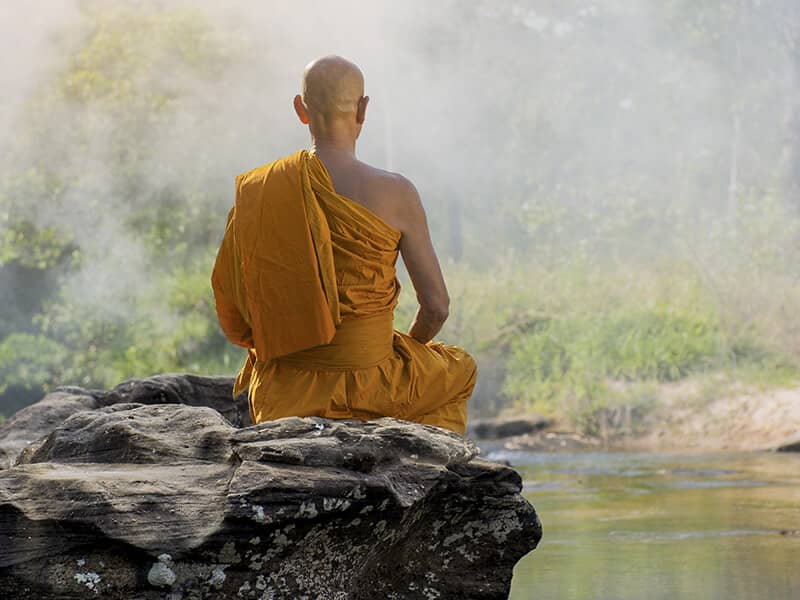
Shutterstock.com
Gautama’s father was the king of a large clan called the Shakyas in Lumbini – which is now known as the modern-day Nepal. During his father’s ruling in the 6th century B.C., Lumbini was known to be economically very poor and considered to be the geographically the outskirts. Seven days after his birth, Gautama’s mother passed away. There is not a lot of documentation about her death, but it’s said that a holy man prophesized that the young Siddhartha would be capable of great things. The holy man said that Siddhartha would either be a great king, military leader or an all knowing spiritual leader.
With these prophecies in mind, Gautama’s father decided to keep his son away from the suffering taking place in the world and shielded him from witnessing the everyday miseries. Gautama was raised in a palace, built for the boy and even went as far to shelter him from the knowledge of religion and human hardship. The culture’s custom required him to wed through an arranged marriage at the age of 16 years-old. Even though this happened, he still lived a life of total seclusion for another 13 years.
When Gautama was in his late 20s he ventured outside of the palace walls and quickly was faced with the realities of the world. He was in awe over the disparity that encompassed those outside of the palace walls. After seeing the sights, the next day, at 29 years old, Gautama left his kingdom. He left behind his wife and son to live an ascetic life. He wanted to discover a way to help with the universal suffering that he now understood – he knew that would begin by better understanding the philosophies behind the traits of humanity.
Over the next six years, Gautama lived an ascetic life and studied practices on meditation. While practicing his new way of life, he followed a group of five ascetics. What’s surprising, is the five ascetics were so impressed by Gautama that they became faithful followers. His teachers were awestruck over his determination and resilience. When answers did not surface to Gautama’s questions, he redoubled his efforts, endured more pain, fasted longer and even refused water.
The story says that a little girl offered Gautama a bowl of rice. Once he accepted it and ate, he realized that the extreme behavior he was living out did not point towards the direction of inner liberation. He learned that living under harsh physical conditions wasn’t the answer to the spiritual release he set out for. After this realization, Gautama urged others to follow a path of balance instead of the one he painted out through extremities – he named this path of life the Middle Way.
After realizing his extreme way of living wasn’t getting him anywhere, Gautama say under a Bodhi tree. He vowed to not get up until the truth he sought came to him and he decided to meditate in hopes of finding those much-needed answers. Gautama sat under the tree for several days. During this time, he said that he was able to purify his mind, see his entire life and previous lives, and his thoughts. It was during this time, he defeated Mara, an evil demon, who challenged his right to become the Buddha. Historians say when Mara attempted to claim the right of Buddha, Gautama simply touched his hand to the ground and asked the Earth to stand as his witness because he achieved enlightenment. When he did this, Mara was banished. In that moment of pure enlightenment, a tranquility, Siddhartha Gautama became “he who is awake” or better known as the original Buddha.
Interestingly enough, but certainly not out of character, Buddha was hesitant to teach others and share his new knowledge because he was aware of his own journey and how long it took him to get to this definitive point. To be honest, Buddha wasn’t entirely certain that he would even be able to communicate to others the words necessary to speak of true enlightenment. The legend claims that the king of gods, Brahma, was the one who convinced Buddha to teach. According to the legend, Brahma was the only one to convince Buddha to get up from his spot under the Bodhi tree and teach others.
It is said the five ascetics who pledged, but later abandoned Buddha attended the Buddha’s first sermon where he discussed the Four Noble Truths and the Eightfold Path – these concepts would later become the pillars of Buddhism. After the sermon, those five ascetics became the Buddha’s first disciples and together they formed the foundation of the Sangha. Historians also commonly refer to the Sangha as a community of monks. During this time, it was unheard of, but women were admitted to the Sangha. In fact, all barriers of class, race, sex and previous background were ignored. The end goal for everyone rested upon the desire to reach enlightenment through the banishment of suffering and spiritual emptiness.
For the next 80 years, Buddha traveled and preached the Dharma, with the hope his efforts would lead others to and along the path of enlightenment. When the Buddha passed away, he told his disciples that should follow no leader and should seek out the continued path with themselves as the driving force.
The original Buddha’s teachings and influence over history is quite astounding. His teachings have inspired a variety of faiths, literature and philosophy. Despite his final request, it’s evident that the Buddha’s ideals of enlightenment were so profound that a new leader wasn’t necessary because his proclamation was strong enough.

